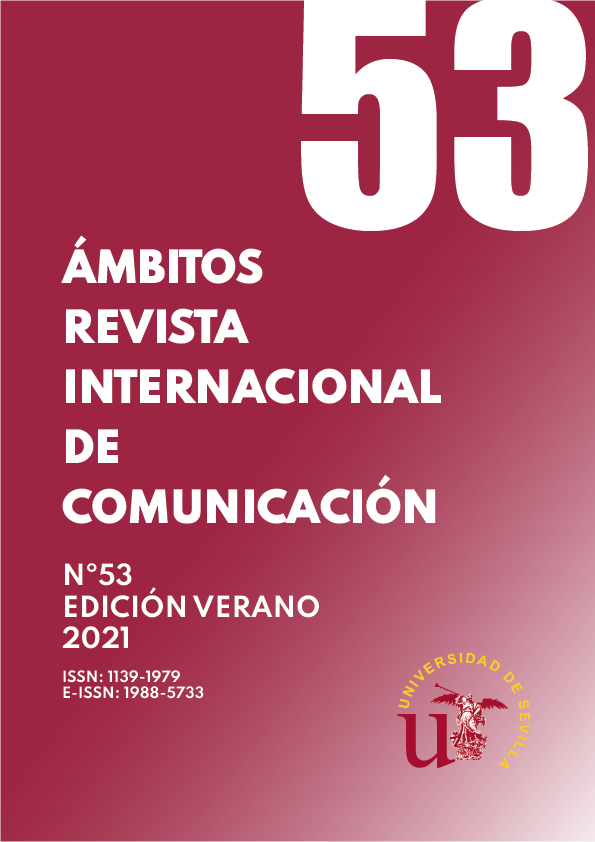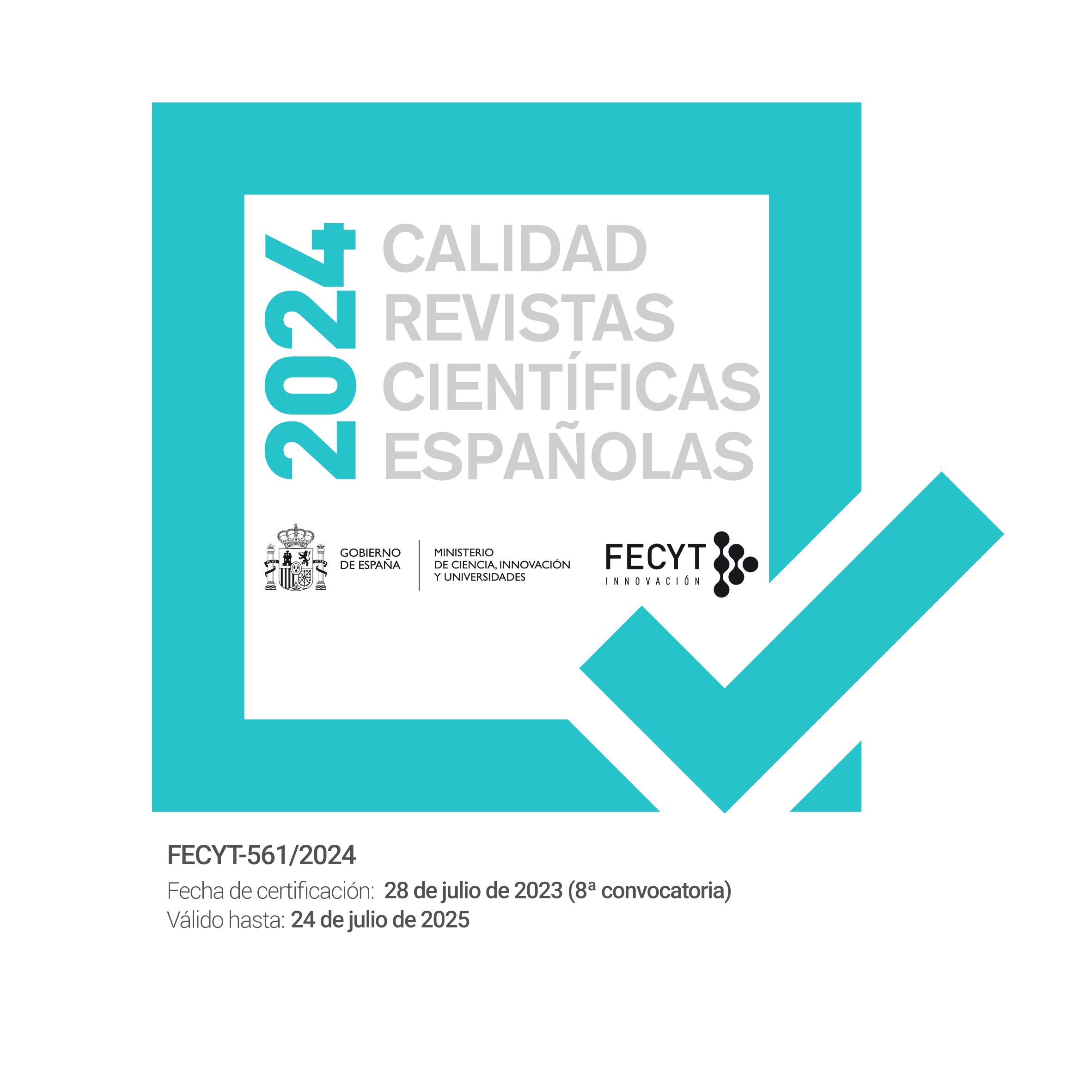Television and enviroment: covergage Madrid’s Climate Summit in Antena 3, Telecinco and TVE Lunchtime News
DOI:
https://doi.org/10.12795/Ambitos.2021.i53.09Keywords:
Environment, Journalism, Climate change, News, Lunchtime newsAbstract
The present study analyzes the informative coverage of the Madrid Climate Summit in TVE, Antena 3 and Telecinco television news, in its Lunchtime.The object is to determine how the medias has attended this news and check if they are transmitted from a pedagogical point of view that allows raising awareness of the need to take measures to alleviate the consequences of global climate change. For this research, was adopted a mixed method in the analysis of the 381 news items broadcast between November 31 and December 15, in order to also collect information prior to the event. The results show the importance given by the news to the negotiations between the countries participating in the Summit, but also to the reports related to the environment and the sustainability of diversity. There is also a growing interest in the media to become allies in the fight against global climate change and to offer well-founded information, close in space and time, and too far removed from catastrophic positions. However, we still have a challenge before us, verify that televisions are able to stand the climate crisis’s attention or if it’s a specific event associated to the demand for information of the World Summit.
Downloads
References
Águila, J.C. y Teso, G. (2011). Aplicación del Protocolo de Registro y Análisis de las noticias sobre el Cambio Climático (CC) en los programas informativos diarios en España [Ponencia]. III Congreso Internacional Latina de Comunicación Social. Universidad de La Laguna, Tenerife, España.
Águila, J. C. (2016). La comunicación del cambio climático: análisis del discurso de los telediarios españoles sobre las cumbres de Cancún y Durban [Tesis doctoral inédita, Universidad Complutense de Madrid]. https://bit.ly/2RJTX7q
Alonso-González, M. (2020). Tiempo y medioambiente como ejes noticiosos en los informativos de TVE, Antena 3 y Telecinco. Miguel Hernández Communication Journal, 11(2), 315-336. http://dx.doi.org/10.21134/mhcj.v11i0.337
Arévalo, C. (2012). Climate Change Summit beyond Copenhagen, Who Goes, Who Stays, and How Are They Covered? University of Oxford.
Bachetta, V. (2012). Perfil del periodista ambiental. Sala de Prensa, 42(2). https://bit.ly/3oEqEyq
Barlovento (2019). Análisis Audiencias TV: Diciembre 2019. https://bit.ly/3nG4U42
Calvo Hernando, Manuel (1996). Panorama de periodismo ambiental en España. APIA.
Cáceres, M.D., Sánchez Calero, M. L. y Morales, E. (2012). La representación televisiva del cambio climático: las noticias sobre la Cumbre de Cancún en las cadenas españolas. Index Comunicación, 2 (1), 113-128.
Cobb, R. y Elder, Ch. (1972). Participation in American Politics: The Dynamics of Agen-da-Building. Johns Hopkins University Press.
Comisión Europea (2020). Consecuencias del Cambio Climático. https://ec.europa.eu/clima/change/consequences_es
CMNUCC (1992). Convención Marco de las Naciones Unidas sobre el Cambio Climático. https://bit.ly/3skEbNS
De Rueda, A. (2014). El discurso político y el tratamiento periodístico del cambio climático en la prensa española durante las Conferencias de las Partes de Naciones Unidad: de Copenhague (2009) a Varsovia (2013). [Tesis doctoral, Universidad Cardenal Herrera- CEU]. Repositorio Institucional CEU. https://repositorioinstitucional.ceu.es/handle/10637/7389
De Sola, J. (2020). La cobertura de la Cumbre del Clima Chile Madrid COP25 en los informativos de la radio española. adComunica. Revista Científica del Estrategias, Tendencias e Innovación en Comunicación, 20, 205-230. DOI: http://dx.doi.org/10.6035/2174-0992.2020.20.9.
Digital News Report (2020). Los medios afrontan los retos de recuperar una confianza debilitada y seguir ampliando ingresos por suscripciones. https://www.digitalnewsreport.es/
Ertivi, C. y De Lara, A. (2012): Las imágenes televisivas del cambio climático. Estudio de la cobertura de la Cumbre de Durban en los informativos españoles. Revista Comunicación, 10, 1466-1481.
Escudero, L., Lois, R. y Martí, A. (1999). La cuestión del cambio climático, realidad y noticia. Una aproximación desde el territorio gallego. Revista de Geografía, 32, 67-78.
Fahn, J. (2008). Rescuing reporting in the global South. Media coverage of climate change lags behind in the countries where it matters most. Nature Reports Climate Change, 2, 88-90.
Fernández, J. (2001). Dos siglos de periodismo Ambiental. Caja de Ahorros del Mediterráneo.
Fernández Parrat, S. (2006). La Información Ambiental en los medios de comunicación. Telos, 68, 1-10.
Fernández-Reyes, R., Piñuel-Raigada y Mariño, M. (2015). La cobertura periodística del cambio climático y el calentamiento global en el El País, el Mundo y la Vanguardia. Revista Latinoamericana de Comunicación Social, 70, 122-140. https://doi.org/10.4185/RLCS-2015-1038.
Francescutti, L. P., Tucho Fernández, F. e Íñigo Jurado, A. I. (2013). El medio ambiente en la televisión española: análisis de un año de informativos. Estudios sobre el Mensaje Periodístico, 19 (2), 683¬-701.
Heras, F., Meira, P. y Benayas, J. (2016). Un silencio ensordecedor. El declive del cambio climático como tema comunicativo en España 2008-2012. Redes.com: revista de estudios para el desarrollo social de la Comunicación, 13, 31-54.
Jiménez Gómez, I. (2017). Hablemos del tiempo. El imaginario publicitario del cambio climático. Ámbitos, 37, 1-12. http://dx.doi.org/10.12795/Ambitos.2017.i37.04
Ladle, R., Jepson, P. y Whittaker, R. (2005). Scientists and the media: the struggle for legitimacy in climate change and conservation science. Interdisciplinary Science Reviews, 30(3), 231-240. https://doi.org/10.1179/030801805X42036
León, B. (Coord.) (2016). El medio ambiente en el nuevo universo audiovisual. UOC
León, B y De Lara, A. (2013). Ciencia y cambio climático. Estudio de la cobertura del cambio climático en la prensa española, en R. Fernández-Reyes (dir.) y R. Mancinas (coord.), Libro de Actas de las Jornadas Internacionales Medios de Comunicación y Cambio Climático (pp.91-104). Fénix Editora.
León, B. y Erviti, M. (2011). Portrayal of scientific controversy on climate change. A study of the coverage of the Copenhagen summit in the Spanish press. Observatorio Journal, 5(3), 45-63.
León, B. y Erviti, C. (2013). Science in pictures. Visual representation of climate change in Spain’s television news. Public Understanding of Science, 24(2), 183-199.
Lizcano, J. L. (2009). Hacia una normalización de la información corporativa. El reporte de RSC y los sistemas de verificación. Cuaderno Telos, 79.
Lomborg, B. (2003). El ecologista escéptico. Espasa Calpe.
Lopera, E. (2013): La Comunicación social de la ciencia del clima en la prensa española: texto y contexto. Colección Documentos Ciemat.
Lorente, J. I., Antolín, J. E., Doblas, F.J. (2009). La construcción mediática de lo ecológico. Estrategias discursivas en la información de actualidad. Revista Latina de Comunicación Social, 64, 315-327.
Macinas, R. (2013). El silencio mediático. Reflexión en torno a las razones de los medios de comunicación para no hablar del cambio climático, en R. Fernández-Reyes (dir.) y R. Mancinas (coord.), Libro de Actas de las Jornadas Internacionales Medios de Comunicación y Cambio Climático (pp. 233-248). Fénix Editora.
Mercado, M. (2013). El análisis del tratamiento informativo del cambio climático, en R. Fernández-Reyes (dir.) y R. Mancinas (coord.), Libro de Actas de las Jornadas Internacionales Medios de Comunicación y Cambio Climático (pp. 123-134). Fénix Editora.
Moreno, P. (2012). El reportaje televisivo y sus interpretaciones de la realidad. Estudios sobre el Mensaje Periodístico,18 (2), 823-832.
Nisbet, M. C. (2009). Communicating climate change: Why frames matter for public engagement. Environment: Science and Policy for Sustainable Development, 51(2), 12-23.
Nossek, H. y Kunelious, R. (2012): News flows, Global Journalim and Climate Summits, en E. Eide y R. Kunnelius (eds.), Medida Meets Climate (pp.67-85). Nordicom.
Pew Research Center (2019). Climate Change Still Seen as the Top Global Threat, but Cyberattacks a Rising Concern. https://pewrsr.ch/3nzT9ME
Picó Garcés, J. M: (2017). Periodismo ambiental: de la lucha ecologista al entorno digital. UOC.
Piñuel, J. L., Gaitán, J. A. y Lozano, C. (2012). Los telediarios ante el cambio climático. La deriva de la información sobre la catástrofe en las cumbres del clima y en tiempos de calma [ponencia], IV Congreso Internacional Latina de Comunicación Social. Universidad de La Laguna, Tenerife, España.
Reig, R. (2010). Condicionantes estructurales del trabajo del periodista: las causas de una sociedad desinformada. Global Media Journal, 7(14), 39-59.
RTVE (2019). Un telediario del futuro. Recuperado de https://bit.ly/3sfh8UJ.
Ripple, W., Wolf. C., Newsome, T., Barnard P. y Moomaw, W. (2019). World Scientists’ Warning of a Climate Emergency. BioScience, 69 (11). https://doi.org/10.1093/biosci/biz088
Rodríguez Cárcela, R. (2011). La información de sucesos. Temática en prensa escrita. Correspondencias & Análisis, 1, 309-325.
Rojo, T. y Dudu, S. (2017). Los videojuegos en la implementación de políticas de mitigación del cambio climático. Ámbitos, 37, 1-23. http://dx.doi.org/10.12795/Ambitos.2017.i37.06
Sánchez Calero, Mª L., Morales, E. y Cáceres, Mª. D. (2012). La cobertura televisiva de la cumbre de Cancún: Agenda Temática, discursos y fuentes en los informativos españoles. Index Comunicación, 2, 113-128.
Semetko, H.A. y Valkenburg, P. M. (2000): Framing european politics: analysis of press and TV news. Journal of Communication, 1, 93-109.
Tankard, J. W. (2001). The empirical approach to the study of media framing, en S. D. Reese, D. Stephen, O.Gandy, y A.Grant. (eds.), Framing public life. Perspectives on media and our understanding of the social world (pp.95-106). Lawrence Erlbaum Associates.
Teso, G. (2016). Comunicación y representaciones del cambio climático: el discurso televisivo y el imaginario de los jóvenes españoles. [Tesis doctoral, Universidad Complutense de Madrid. Madrid]. https://eprints.ucm.es/41736/
Teso, G., Fernández-Reyes, R., Gaitán Moya, J. A., Lozano Asencio, C. y Pinuel Raigada, J. L. (2018). Comunicación para la sostenibilidad: el cambio climático en los medios. Fundación Alternativas.
Kolberte, E. (2006). Field notes from a catastropher: man, nature an climate change. Blomsbury.
Vicente, M. y López, P. (2009). Resultados de la investigación en comunicación sobre framing: sólido avance y arranque de la especialidad en España. ZER, 26, 13-34.
Downloads
Published
How to Cite
Issue
Section
License
Copyright (c) 2021 Marián Alonso González

This work is licensed under a Creative Commons Attribution-NonCommercial-ShareAlike 4.0 International License.
Ámbitos. Revista Internacional de Comunicación is an open access journal, which means that all content is freely available at no charge to the user or their institution. Users may read, download, copy, distribute, distribute, print, search or link to the full text of articles, or use them for any other lawful purpose, without seeking prior permission from the publisher or author. This definition of open access is in accordance with the Budapest Open Access Initiative (BOAI).

Unless otherwise noted, all content in the electronic edition is distributed under a "Creative Commons Attribution-NonCommercial-ShareAlike 4.0 International License". You can consult the informative version and legal text of the licence here. This should be expressly stated in this way where necessary.
In case of acceptance of the manuscript, the authors cede the rights of the work for its publication to Ámbitos. Revista Internacional de Comunicación under the Attribution-NonCommercial-ShareAlike 4.0 International license contract (CC BY-NC-SA 4.0). The authors retain copyright and third parties are authorised to copy, distribute and make use of the work, provided they comply with the terms and conditions set out in the licence
- Cite the authorship and the original source of publication (journal, publisher and URL of the work).
- Do not use them for commercial purposes.
- If you remix, transform or create from the material, you must release your contributions under the same license as the original.
More information can be found at https://creativecommons.org/licenses/by-nc-sa/4.0/deed.es


















